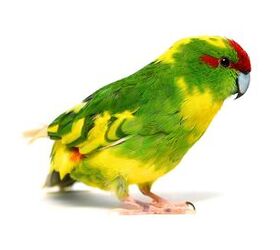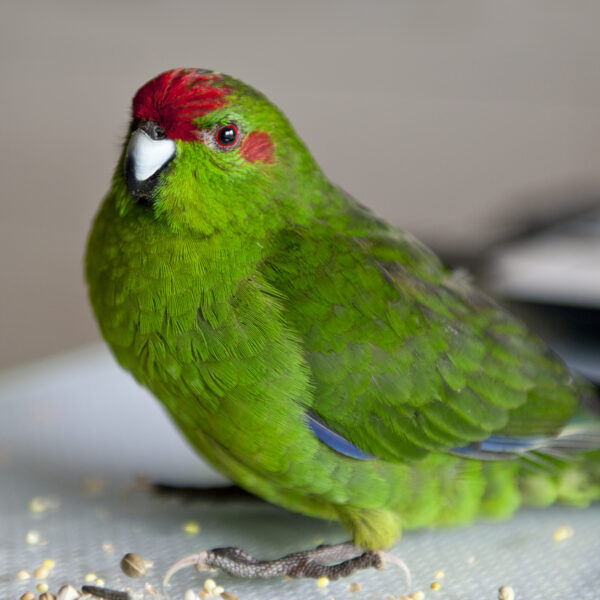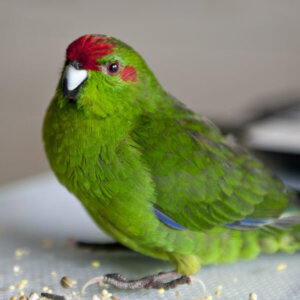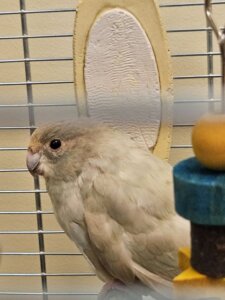What Fruit And Veg Can Kakarikis Eat: A Complete Guide
Kakarikis are lively, colorful parrots. They need a varied diet to stay healthy.
Understanding what fruits and vegetables these birds can eat is crucial. Kakarikis thrive on a mix of seeds, fruits, and vegetables. Fresh produce provides essential vitamins and nutrients. Offering a variety of foods keeps them interested and active. It also helps mimic their natural diet in the wild.
But not all fruits and vegetables are safe for them. Some can be harmful or toxic. Knowing which ones to avoid is just as important. This guide will help you choose the best fruits and vegetables for your Kakariki. Ensuring they enjoy a balanced, nutritious diet will keep them happy and healthy. Let’s explore the best options for your feathered friend.
Introduction To Kakarikis
Kakarikis can eat a variety of fruits and vegetables. They enjoy apples, carrots, berries, and leafy greens. Offering a mix of these foods keeps them healthy and happy.
Kakarikis are small, colorful parrots native to New Zealand. Their bright feathers and playful nature make them popular pets. Understanding their needs is crucial for their health.About Kakarikis
Kakarikis are known for their vibrant green and red plumage. They are active and curious birds. They love to explore their surroundings and interact with their environment. Their playful behavior requires mental stimulation.Importance Of Diet
A balanced diet is essential for Kakarikis. It ensures they get the nutrients they need. Fresh fruits and vegetables are a vital part of their diet. Proper nutrition helps maintain their energy levels and overall health. “`Safe Fruits For Kakarikis
Kakarikis are vibrant and active parrots. They love a variety of foods. Providing them with safe fruits is essential. It ensures their health and happiness. Explore the list of safe fruits below.
Apples And Pears
Apples are a great choice for Kakarikis. They are rich in vitamins. Remove seeds before feeding. The seeds contain cyanide, which is harmful. Slice the apple into small pieces.
Pears are also safe. They are juicy and sweet. Like apples, remove the seeds. Cut them into bite-sized pieces. Pears provide essential nutrients. Your Kakariki will love them.
Berries And Grapes
Berries are perfect for Kakarikis. They are small and easy to eat. Blueberries, strawberries, and raspberries are safe. Berries are packed with antioxidants. They support your bird’s immune system.
Grapes are another safe fruit. They are sweet and hydrating. Offer seedless grapes to avoid choking. Cut them in half for smaller bites. Grapes are a great treat in moderation.
| Fruit | Preparation | Benefits |
|---|---|---|
| Apples | Remove seeds, slice into small pieces | Rich in vitamins |
| Pears | Remove seeds, cut into bite-sized pieces | Juicy and sweet, essential nutrients |
| Berries | Wash thoroughly, serve whole | Packed with antioxidants |
| Grapes | Offer seedless, cut in half | Sweet and hydrating |
Vegetables Kakarikis Can Eat
Kakarikis are active, playful birds with a diverse diet. Offering them a variety of vegetables ensures they receive essential nutrients. This section covers the vegetables Kakarikis can eat, including leafy greens and root vegetables.
Leafy Greens
Leafy greens are a great source of vitamins and minerals for Kakarikis. They provide fiber, which aids digestion. Here are some leafy greens you can offer:
- Spinach: Rich in iron and calcium, but feed in moderation.
- Kale: Packed with vitamins A, C, and K.
- Romaine Lettuce: Hydrating and low in calories, good for hot days.
- Swiss Chard: Contains essential nutrients like magnesium and potassium.
Root Vegetables
Root vegetables are another nutritious option for Kakarikis. They are often rich in vitamins and minerals. Consider these root vegetables:
- Carrots: High in beta-carotene, which converts to vitamin A.
- Sweet Potatoes: Full of fiber, vitamins, and antioxidants.
- Beetroot: Provides folate and manganese, enhancing overall health.

Credit: www.northernparrots.com
Avoiding Harmful Foods
Feeding your Kakarikis the right foods is essential for their health. They are curious birds, and will often try to eat anything they find. Knowing which fruits and vegetables are harmful is crucial for their well-being.
Toxic Fruits
Some fruits can be toxic to Kakarikis. Avoid feeding these fruits to your birds:
- Avocado: Contains persin, which is toxic to birds.
- Rhubarb: Contains oxalic acid, harmful to Kakarikis.
- Cherries, Apricots, Peaches, and Plums: The pits contain cyanide, which is dangerous.
Always remove seeds and pits from fruits. This prevents accidental ingestion of harmful substances.
Unsafe Vegetables
Not all vegetables are safe for Kakarikis. Here are some to avoid:
- Onions and Garlic: Can cause digestive issues and damage red blood cells.
- Potatoes: Raw potatoes contain solanine, a toxic substance.
- Mushrooms: Some mushrooms contain toxins harmful to birds.
Feed your Kakarikis safe vegetables instead. Carrots, broccoli, and leafy greens are good choices. Always wash vegetables thoroughly before feeding.
Nutritional Benefits
Kakarikis are delightful and active parakeets that thrive on a varied diet. Feeding them a wide range of fruits and vegetables ensures they receive essential nutrients. Let’s explore the nutritional benefits of incorporating these foods into their diet.
Vitamins And Minerals
Fruits and vegetables provide essential vitamins and minerals that are crucial for Kakarikis’ health. Here are some key nutrients:
- Vitamin A: Found in carrots, sweet potatoes, and leafy greens. Supports vision and immune function.
- Vitamin C: Present in bell peppers, strawberries, and citrus fruits. Boosts the immune system and aids in healing.
- Calcium: Available in broccoli, kale, and figs. Essential for bone health and muscle function.
- Iron: Found in spinach, peas, and apricots. Important for blood health and energy levels.
Hydration And Fiber
Fruits and vegetables are high in water content and fiber, which are vital for Kakarikis:
- Hydration: Cucumbers, melons, and oranges help keep Kakarikis hydrated. Proper hydration supports overall health.
- Fiber: Apples, pears, and green beans provide necessary fiber. Fiber aids in digestion and prevents constipation.
Ensure a balanced diet with a mix of these fruits and vegetables to support your Kakariki’s health.
Introducing New Foods
Introducing new foods to your Kakarikis can be an exciting journey. These birds are naturally curious and enjoy exploring different tastes and textures. Adding a variety of fruits and vegetables to their diet ensures they get a balanced intake of nutrients. This section will guide you through the process of safely introducing new foods to your feathered friend.
Gradual Introduction
Start by adding small portions of the new food to their regular diet. Gradually increase the quantity over a week. This helps your Kakariki to get accustomed to the new taste without overwhelming their digestive system.
Below is a simple plan to introduce new foods:
| Day | Amount of New Food |
|---|---|
| 1-2 | 1/8 of the regular diet |
| 3-4 | 1/4 of the regular diet |
| 5-6 | 1/2 of the regular diet |
| 7+ | Full portion |
Monitoring Reactions
Observe your Kakariki closely during this period. Look out for any signs of adverse reactions. These can include changes in droppings, unusual behavior, or loss of appetite. If you notice any negative symptoms, stop the new food immediately and consult a vet.
Create a simple log to track their reactions:
- Day and time of introduction
- Type and amount of food given
- Any observed reactions
This log helps in pinpointing any specific foods that might not suit your Kakariki.
Balancing The Diet
Feeding your Kakarikis a balanced diet is essential for their health. A varied diet keeps them active and happy. This section will explore the right proportions and variety, and the role of supplemental foods.
Proportions And Variety
It’s crucial to offer a mix of fruits and vegetables. This ensures they get all necessary nutrients. Aim for a diet that consists of:
- 40% vegetables
- 30% fruits
- 30% seeds and pellets
Vegetables like carrots, broccoli, and spinach are excellent choices. Fruits such as apples, berries, and mangoes are also good. Avoid citrus fruits as they can upset their stomach.
Variety is key. Rotate different fruits and vegetables weekly. This prevents boredom and ensures a balanced intake of nutrients.
Supplemental Foods
Supplemental foods provide additional nutrition. They are not a replacement for their main diet.
| Food | Benefit |
|---|---|
| Boiled eggs | High in protein |
| Nuts | Rich in healthy fats |
| Whole grains | Great for digestion |
Offer these foods in moderation. Too much can lead to weight gain. Kakarikis enjoy a well-balanced diet. This keeps them healthy and active.

Credit: leashingler.wixsite.com
Common Feeding Mistakes
Feeding your Kakariki a balanced diet is vital for their health. Yet, many pet owners unknowingly make common feeding mistakes. These mistakes can harm your bird’s well-being. Let’s explore these common pitfalls.
Overfeeding Issues
Overfeeding your Kakariki can cause serious health problems. They may gain weight, leading to obesity. Obesity can shorten their lifespan.
Offer small portions of fresh fruits and vegetables. Avoid giving too many seeds or nuts. Seeds and nuts are high in fat.
Here is a simple guide:
| Food Type | Frequency |
|---|---|
| Fruits | 3-4 times a week |
| Vegetables | Daily |
| Seeds/Nuts | Once a week |
Ignoring Preferences
Kakarikis have food preferences like humans. Ignoring these preferences can lead to uneaten food. This means they miss vital nutrients.
Observe what your bird likes. Offer a variety of foods. Introduce new foods slowly.
Use these tips to cater to their tastes:
- Mix new foods with their favorites
- Rotate different fruits and vegetables
- Note which foods they enjoy the most
By avoiding these common mistakes, you can ensure your Kakariki stays healthy and happy.

Credit: www.petguide.com
Frequently Asked Questions
What Fruits Can Kakarikis Eat?
Kakarikis can eat a variety of fruits including apples, pears, berries, and grapes. Ensure fruits are washed and cut into small pieces. Avoid seeds and pits.
Can Kakarikis Eat Vegetables?
Yes, Kakarikis can eat vegetables like carrots, broccoli, spinach, and peas. Make sure vegetables are fresh and finely chopped. Avoid toxic vegetables like onions.
Are There Any Fruits Kakarikis Should Avoid?
Kakarikis should avoid fruits with high acidity like citrus fruits. Also, avoid fruits with seeds or pits like cherries and plums.
How Often Should Kakarikis Eat Fruit And Veg?
Feed Kakarikis fruit and vegetables daily. They should make up about 30-50% of their diet. Ensure a balanced variety for optimal health.
Conclusion
Kakarikis enjoy a variety of fruits and vegetables. Fresh produce keeps them healthy. Offer apples, grapes, and berries. Carrots, spinach, and peas are great choices too. Avoid toxic foods like avocado and chocolate. Balanced diet ensures your Kakariki’s well-being. Regularly introduce new foods to their diet.
Monitor their reactions to new items. Happy, healthy birds thrive on diverse nutrition.
Hello Dear, I'm Poli Kolymnia, owner of many birds (including budgies).
With a deep passion for these feathered companions, I'm here to share my expertise and extensive knowledge on birds care.
My articles cover essential topics like diet, housing, care, and health, providing practical tips to help you create a happy and thriving environment for your birds.






